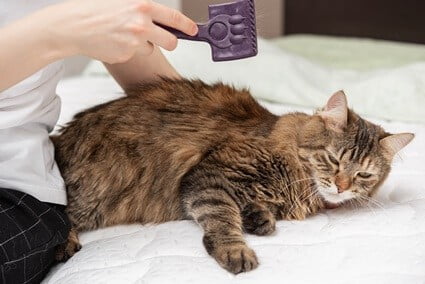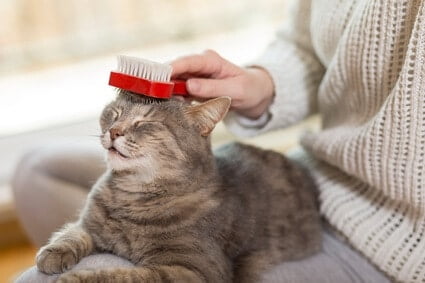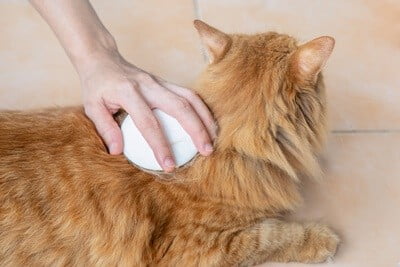When cats advance in years, they sometimes require help with cleaning their fur. As their joints become stiffer and energy levels diminish, older cats may no longer be able to lick themselves clean and remove any dead fur. That’s why you need to know how to clean a senior cat’s fur.
An old cat should be groomed daily with a soft, hollow-bristled brush to distribute its bodily oils evenly around the fur. To compensate for an older cat’s inability to lick itself clean, use unscented wipes to clean its bottom region, as this area usually gets much dirtier.
Elderly cats may take a while to warm up to being cleaned by you, and it may make them feel uncomfortable. However, feeling unclean can cause a cat distress. Therefore, with consistency and gentleness, older cats will usually welcome your efforts to keep their fur clean.
Why Do Older Cats Stop Cleaning Themselves?
Cats are meticulous groomers, so your older cat has likely stopped cleaning itself due to physical or mental inability rather than laziness or unwillingness.
The grooming process requires flexibility, dexterity, and fitness. Unfortunately, a cat’s back legs will become stiff, its cognitive function limited, and its flexibility diminished in its old age.
For example, Small Animal Practice found that the onset of osteoarthritis in older cats is often the cause of their inability to clean themselves. Also, the same scientific study found that most cats over the age of 10 will experience osteoarthritis to some degree.
Cat Not Grooming and Losing Weight
You may find that, along with the ability to groom itself, your senior cat is unexpectedly losing weight.
In their old age, cats are more likely to contract medical issues that lead to sudden weight loss, such as diabetes or hyperthyroidism. So, use the tips and advice in this article to help your cat gain weight.
Perhaps your older cat isn’t grooming and losing weight due to psychological stress, such as anxiety or depression. Here are some factors that could lead to your older cat becoming stressed.
Old Cat with Greasy Fur
As a cat gets older, its inability to clean itself can result in the oils produced by its skin failing to be evenly distributed throughout its fur. This causes an elderly cat’s coat to become greasy or oily.
If you find that your older cat has greasy fur, you should use a soft brush to gently groom your cat to distribute the oils more evenly.
The most common cause of greasy fur in older cats is aging joints, diminished physical fitness, and underlying health conditions.
Senior Cat Has Matted Fur
Senior cats often get tangled fur due to their inability to clean themselves, resulting in certain parts of their fur becoming clumpy and matted.
If this is the case, use a soft brush to groom it daily and work out the mats. If you’re unsure about doing so or your cat is proving to be difficult, utilize the services of a professional pet groomer.
How Do You Clean an Old Cat?
Once your cat has aged beyond 10 years, it may need help grooming.
To compensate for your cat’s lack of ability or interest, you’ll introduce grooming at least daily, but ideally twice a day to replicate your cat’s normal grooming routine.
At first, your cat may be annoyed at you brushing its fur. Over time, with enough consistency, it will start to appreciate your efforts and enjoy the attention.
To clean an old cat, use a soft-bristled brush to groom its fur and distribute its skin oils evenly. When an older cat loses its ability to clean itself, the most immediately affected areas are along its spine and on its bottom. Therefore, you should pay extra attention to these two areas.
If you have a long-haired cat breed, you should ideally groom it more often. Long fur tends to become greasy and clump up much faster than short fur, and there’s more dead fur to remove.
The best time of the day to groom your cat is when it’s in its most docile state, which is usually after your cat has had a meal or played. You should avoid grooming an agitated cat.

How To Clean Cat’s Fur without Water
The best way to clean a cat’s fur without water is to use a brush. Like all animals, a cat’s skin produces natural bodily oils, which it distributes across its fur evenly with its tongue when it grooms itself. However, you can replicate the same process using a soft brush.
Older cats have thinner skin, which means you’ll have to be mindful of the grooming tools you use. Use gentle strokes to minimize any discomfort your cat may feel. A brush with hollow bristles is ideal.
The National Academy of Sciences found that a cat’s tongue contains tiny structures that act much like the hollow bristles of a soft grooming brush.
Therefore, using such a brush will replicate the sensation a cat experiences when it grooms itself, making the process more comfortable.
Following this grooming process:
- Begin by petting your cat to make it feel relaxed and comfortable.
- Start at the tip of the head, using the brush to groom in the direction of the fur growth.
- Slowly work your way down your cat’s back and tail, and move on to its sides and belly.
- Once you have groomed and cleaned all of the cat’s fur, check for parasites with a flea comb.
Cats are guarded about exposing their belly to contact, so you may need to give your cat time to adjust. Also, never brush against the grain of the fur as cats have very sensitive skin.
How To Remove Clumps from Cat Fur
Clumps can be removed using water to soften the cat’s matted or tangled-up fur, so you can brush the mats out. Using water from a spray bottle, lightly soak the clumps in your cat’s fur.
However, cats may not appreciate having their fur wetted, in which case, you can sprinkle cornstarch or baking powder over the clumps instead. This will make the mats softer and easier to brush out.
If your cat’s fur is much too matted and clumped to be brushed out, you may have to use a pair of scissors to score out the knots and tangles creating the clumps.
If so, do the following:
- Lift up the clumped fur with your fingers without pinching your cat’s skin.
- Use a pair of blunt-nosed scissors to score tangled fur and cut it open.
Remember, you are not cutting your cat’s fur with the scissors here. Instead, you are using the sharp edge of the scissors to score the tangles and open them up without cutting or pulling on the skin.
While you can use scissors to cut away the more stubborn knots, this should be your last resort. Once the tangled fur has been separated, use a soft-bristled brush to smoothen the clumps.
Removing all the tangles and clumps in your cat’s fur may take several days. However, if you’re grooming your cat’s fur regularly, this will reduce the chances of the knots and tangles arising again.

How To Wash a Senior Cat
Simply using a brush isn’t enough to replicate your cat’s grooming process.
You’ll also need to wash your cat’s fur from time to time to make sure that it’s properly clean. If your cat refuses a water bath, as it’s likely to do, use unscented wet wipes.
Wet wipes are ideal because they contain moisture without releasing too much water into your cat’s fur. Ideally, you should use cat-specific, unscented wet wipes, which can be purchased from any pet store.
These wet wipes are designed with the pH of a cat’s skin in mind, thereby reducing the chances of your cat having an allergic reaction.
To wash your senior cat’s fur using wet wipes:
- Relax your cat by seating it in your lap and stroking it gently.
- Continue to stroke your cat’s fur, only now use the wet wipe instead of your fingers.
Perform this process once a day only as excessive washing with wet wipes can dry out a cat’s fur.
How to Encourage a Cat to Groom Itself
While your older cat may lose its grooming ability, you can still encourage it.
To do so, start using a brush to groom it regularly, as this will stimulate the skin and increase its blood circulation, making your older cat more aware of any greasy, clumpy, or dirty areas of its fur.
If your cat starts to groom itself, don’t interrupt it. Importantly, your older cat still won’t have the dexterity to groom its bottom and spine, so you’ll still have to groom these hard-to-reach areas for it.


I have a 21-year-old cat it stresses me and her out to take to the vet
I tried brushing it with a wet brush, but it doesn’t seem to help. I am a senior on a fixed income and cannot take it to the vet more than once yearly, then I have to get someone who will take me in my wheelchair. Is there some discount places I can take it to?
What is a soft, hollow-bristled brush?
Thanks so much for the great information!
You mentioned dry washing older cats when practicable… Is it preferable to give them an actual wash with shampoo? I know that for younger cats, this is not ideal, as it might remove their natural oils, but for older cats, is there anything wrong with taking the approach of buying some shampoo and giving them a gentle bath?
If this is preferable, are there any shampoos that you recommend that will be a little less harsh on their fur?
Currently looking out for a little stray who appears to have fallen on hard times; the back half of his coat is severely matted and he has what appears to be eye and ear infections.
Taking him to the vet, but thought it would be a nice gesture to clean him up a little bit before doing so.
Thanks for anything information you can provide!
I have a male tuxedo cat 23 in May. I found him in a dumpster when he was newborn. I cared for him, and now he is turning 23 in may. He was always so immaculate, but recently, he does not clean himself. And he sleeps on my bed. I’m thinking to put him in a bath with soap. I am so repulsed. He smells really bad. But I know he will go really nuts if i put him in, and I’m not sure there are places that groom such old cats. And how he will react. Even taking him to the vet to cut his nails was impossible. He us healthy, no meds,
But he’s very skinny, and walks very wobbly.
Do u have any ideas how I can keep him clean?
What is a soft hollow hollow bristled brush look like and where to buy it?
Your advice is very clear and well written. thanks!